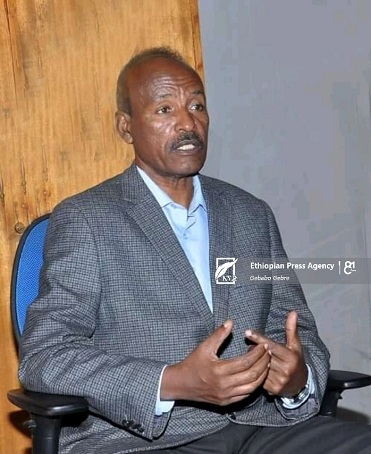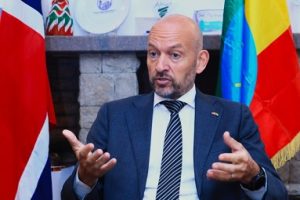
Artist Girma Bulti was born and raised in Abomssa, a town in the Arsi Zone of Oromia State. After completing primary school at his home town he attended secondary school at Abiyot Kirs High school in Addis Ababa.
Girma joined the school of fine arts at Addis Ababa University and received a Bachelor of Arts. He also studied Museology and earned a second degree from the same institution. Right after graduation, Girma served his country in different positions.
To list some, art, design and audiovisual department at the Municipality Office, audiovisual team leader at Information Office of Addis Ababa, culture researcher and supervisor at Addis Ababa Culture and Tourism Bureau, design and audiovisual department head at Children and Youth Theater.
Currently, Girma is working in the Ethiopia National Museum as an Art Curator. Apart from toiling various creative artworks, he is also known for writing and publishing biographies of Young and Elderly artists. He has displayed art exhibitions individually and in a group with other artists.
The artworks of Girma predominantly focus on the culture and history of Ethiopia. He is now due to display his 32nd art exhibition in Addis Ababa. Previously, he demonstrated his works on local and international platforms. The Ethiopia Herald had a short stay with Artist Girma Bulti and discussed a range of issues directly or indirectly connected with the painting and its socioeconomic impact. Have a nice read.
Could you tell me about your style of painting? Do you adhere to the Ethiopian traditional painting style and technique, a modern one or a combination of the two? What is your contribution to perpetuating Ethiopia’s traditional painting techniques?
Ethiopia has its own traditions with regard to art, especially paintings. The country is known for its two-dimensional painting techniques. When Gonder served as the capital of Ethiopia, the two-dimensional painting technique reached its peak. This clearly stipulated that we have had our own painting techniques since ancient times. During that time the two-dimensional paintings, which are not related to forms but focused on messages, were done by Ethiopian artists alone.
As it is based on the bible history and shows a message without following various techniques such as background, foreground forms, distance, perspective, brightness, shadow, boldness etc. The message was done by mixing a range of colours. These colours are presented preserving their tone and holding messages.
When we come up with modern art, Ethiopia’s trade exchange with various countries including that of the Portuguese was a cause for painters to enter Ethiopia.
This window of opportunity paved the way for local and international painters to work in unison. Through time, our painters learnt some and were able to transform themselves from the two-dimensional to the three-dimensional painting technique. Then, -ism was introduced to our country.
Afterwards, Realism came into being. Realism in the arts is generally the attempt to represent subject matter truthfully, without artificiality and avoiding speculative fiction and supernatural elements.
In fact, this is progress. When we transform from traditional to modern art, there are such sorts of paintings and subsequent photography. Following the modern time, offering training is believed to bestow for those who have a talent and tendency to grow the genre. The return of Ethiopian painters who drew lessons from abroad was a window of opportunity to open up a school of fine arts.
This is leapfrogging the modern paintings. Modern painting (professionalism) was introduced at that time even though some artists tried their best to apply modern technology on their own. The cornerstone of painting is realistic art next to drawing.
After graduation, one can develop his own –ism. Following my talent, I received training in the School of Fine Arts and searched my own within modern painting techniques. Even if I have no –ism, as per my feeling and following Ethiopian colour, I tried to apply a combination of what I learnt from art school adding my own creativity.
My painting techniques are neither abstract nor realistic but play in the middle of the two. Neocolonialism is a present challenge for the African continent. Would you say something about the contribution of painters in promoting pan-Africanism? Panting is equivalent to literature.
There is a way of expressing neocolonialism showing how the white people oppressed even sold the black people like any commodity. The sacrifices the black people paid for centuries were clearly registered in literature. When we come to our profession, neocolonialism sentiment has been expressed in painting, sculpture, and modern paintings as well.
The African continent has suitable climatic conditions for paintings. Most of the time painters who are born in colourful countries can explain their environs better than the ones residing in colourless states.
If you go to icy countries, like Russia, you cannot find a variety of colours. Inversely, when you come to Africa, you encounter a number of colours. What makes our tradition peculiar is, there are African mask techniques. These are paintings done together with accessories and installation. This mixed art makes African painting unique.
Presently African art is directly connected with a freedom that defies neocolonialism sentiment. Such sorts of tasks are boldly observed in visual arts and grab the attention of the audience.
Even white people have a desire to admire and buy such artwork. Gebre Kristos Desta, Afework Tekle, Lemma Guya are among the famous Ethiopian painters who have left their fingerprinting in this regard. Therefore, painting expresses culture and history this way.
Why do you think that African art including painting is not developed as per the level it required?
What do you suggest as a professional? It is difficult to conclude that African art has developed to the extent it should. We still have to do a lot of jobs ahead. For this to happen, first, there should be a line that assists Africans to know each other.
An artist in one corner of the continent should meet others so as to create huge artistic works. There are few artists who tried to communicate with others individually. This may lay a cornerstone to uphold African art. Compared with performing art, painters have not been given the chance to travel abroad and promote their works.
At present, we have seen a ray of hope to encourage artists in general and painters in particular. However, much is expected from government and private institutions in order to make the profession competitive in the world arena considering that it has its own contribution to building the image of the country.
You have received a medal from the hands of the premier, what was your feeling during the acknowledgement ceremony?
One of the highest recognition pillars is receiving an award. Receiving a high-level medal from the hands of the prime minister by itself is a very exciting thing. It gives me great pleasure and enhances my morale to do more artistic works than ever. I have received a medal which I have never been thinking about.
The government has given space for the art sector and this makes me more optimistic. The upcoming generation would also perform well if they gain due support. Frankly, it is very impressive.
Africa is endowed with various mineral resources. Have you ever seen the stride to produce paints?
Yes, there are. Each profession has its own genre. It is a chemist that produces paints. There are some people who have talent and others who develop it by studying the subject matter. However, the job of the painter is to draw pictures by mixing various paints. However, an Ethiopian man who graduated in chemical engineering is now producing acrylic paints and supplying for the market considering the shortage of imported ones.
Many of us bought and used it. This is a good jump start and others need to follow suit. In order to solve the shortage of paints, we artists must stand together and echo our voices so as to solve the problems of imported paints. Painting has its own market abroad. However, it is uncommon to see the trend in Ethiopia. If it does not make money, it is likely to discourage the artist.
What is your comment in this regard? With regard to the market of paintings, there are discouraging and encouraging factors.
There are artists who can sell and change their livelihood with the money they earned from paintings. However, others are leaving the profession let alone gaining benefits out of it. Selling a single art means an encouraging factor to the artist to do the next artwork as the money can be used for buying inputs or paying studio rents … etc.
On the other hand, at times when an artist sells his works, he is promoting himself not only for Ethiopians but also for outsiders. In this regard, we have been facing two challenges. One is our society has limited awareness towards paintings. The economic capacity of the country has also constrained our activities.
People’s level of the economy has its own impact as ordinary citizens cannot afford to spend 10,000-20,000 birr for a single artwork. However, every citizen needs to develop a culture of hanging up paintings at home, hotel, office etc as they (the paintings) have the power to create immense pleasure. Nevertheless, this is not possible unless we are doing awareness-raising tasks.
The newly opened hotels are now developing a culture of hanging paintings in their hotels which is a good trend that should further be strengthened. What is more, it is imperative to take policy measures. Every house constructor has to leave some space for paintings as it bestows relief both for the owner and its guests.
These are some points that we need to figure out to solve the inequitable benefit of artists. The communication barrier is the other factor for painters to efficiently promote their works in the international arena and benefit from it.
Dealers and the media need to assist artists via promoting their artworks for the people at large.
Do you have a gallery or studio where people can visit your works? What is your plan for the near future?
I have a studio in my house. I will assume a holistic private museum at the State or City level.
Together with investors, I planned to open a museum that represents the culture of Ethiopian society in paintings. Gallery has dual purposes – one is to earn income from visitors in the form of entrance fees and sell paintings. It is also a workplace for the artist.
What is the parameter for abstract paintings? Does anybody stand up and do abstract works?
Do you have any advice for the young generation? Abstract art does not attempt to represent an accurate depiction of a visual reality but instead uses shapes, colours, forms and gestural marks to achieve its effect.
There are no parameters and limitations for abstract painting. An artist can express his concept freely. The purpose of abstract painting is to bestow freedom for viewers without limiting their outlook as everything in it is not figurative. However, the viewers create an image in their mind and perceive it.
Abstract painting is helpful to discover what is within a single artwork. A painter does not begin the artwork by doing abstract paintings. The centrepiece for painting is realistic art.
After passing many steps, one can reach abstract painting which is one of creative art. However, abstract painting has never been a startup point for beginners. Even if it is a creative art, colours need to have their own harmony, balance and composition. If any one of these is missing, the audience may be angry at the artwork.
Thus, it should keep all the legal grounds. Could you tell us the effort that you made to promote the image of Ethiopia for the rest of the world? As I told you earlier, I focus on the culture and history of Ethiopia. Ethiopia is a mosaic of cultures that one can never come across in other parts of the world. Ethiopia has unique costumes, dressing, food, climatic condition, colours.
All these help me to reflect on the hidden culture of Ethiopia to the rest of the world. Incidentally, through my artistic works, I can raise awareness of people residing in one corner of the country with the others.
If we take Oromia State, for instance, there are wonderful cultures of dressing, marriage, mourning, and so on. I can do a lot of work relying on these cultures which were never done by any of our elders.
I have never seen an artwork done on the Geda system, Irreecha (Thanksgiving Day), Guma (culture of Mediation), Senque (Oromo’s women rights conforming culture). However, I can do a lot of artwork by conducting a study on cultures of nations and nationalities at the grassroots level.
In doing so, I can contribute a little to promote the image of Ethiopia to the rest of the world. Even if I rely on Oromos culture, I did many artworks in connection with the culture of other nations, nationalities and peoples of Ethiopia.
What is the salient objective of your painting? Is it art for art’s sake or used art to convey a social message?
I make artworks for a dual purpose as the saying goes “art is a beauty and a reality” I used to work on various paintings maintaining their artistic value, beauty and showing the reality on the ground in order to win the confidence of locals and international audiences.
I, for instance, come up with an issue that many people talk about in theory but not expressed in paintings. Typical examples for this are the Gudefecha, Mogassa, Hamechissa and Sinque systems of the Oromo people.
I am the first to come up with a painting that reflects those cultures of the Oromo society together with their meanings. There is a saying, “A picture paints a thousand words.”Again most artists agree that a picture is valueless if there is no idea in it. What is your comment? True, a picture is an idea.
The startup point of any kind of picture is an idea. How can you paint in the absence of an idea?
If you don’t have an idea, you could not do anything, let alone paint. The idea can be good or bad. An artist has the right to do any conceptual art. A given painter’s internal perception is reflected in its pictures. By and large, it is unthinkable to do any picture without an idea.
Most of the time pictures have their own power. I care not to do paintings that instigate conflict between two or more groups. Instead, my paintings are pushing people to strengthen solidarity and live in harmony rather than magnifying differences. I am satisfied with drawing pictures that help people to be optimistic.
I am now preparing to show an exhibition entitled Patriotism. It reflects how people pay sacrifices and ensures the sustainability of the country standing as one.
I came across two paintings. One is the patriotism of Ethiopians shown in the Battle of Adwa. How the unity of people helped them to defeat intruders and neo-colonialism sentiment from the land of Africa.
The other picture shows a culture of patriotism in which each and every person in Ethiopia is ready to sacrifice for the common good of the country. More than 20 artists are expected to participate in the exhibition.
What do you suggest for African painters in terms of promoting African culture to the rest of the world society?
Ethiopia’s art should be promoted and enlarged throughout Africa. For this to happen, artists should work hand and glove.
The Africa Painters Association should be established. There are many painters associations in Ethiopia and they should stand in unison to better hold International art symposiums which will be going on this month.
Extended support is also required from the Culture and Sports Ministry in terms of exploiting such a platform as a window of opportunity to promote Ethiopia creating an environment suitable for international artists.
Some activities have been undertaken to establish the African Painters Association
with the objective of correlating countries with one another through exchanging cultures and history.
It also lays the foundation to build their capacity in political, economic and social aspects and play an imperative role to drag the continent from the existing natural and artificial troubles.
Ethiopian artists are working harder to make the country a founding member of the association. So far, artists drawn from 23 countries are showing a good gesture to be a member of the association.
I thank you very much.
It is my pleasure.
BY GIRMACHEW GASHAW
The Ethiopian Herald 12 February 2022





